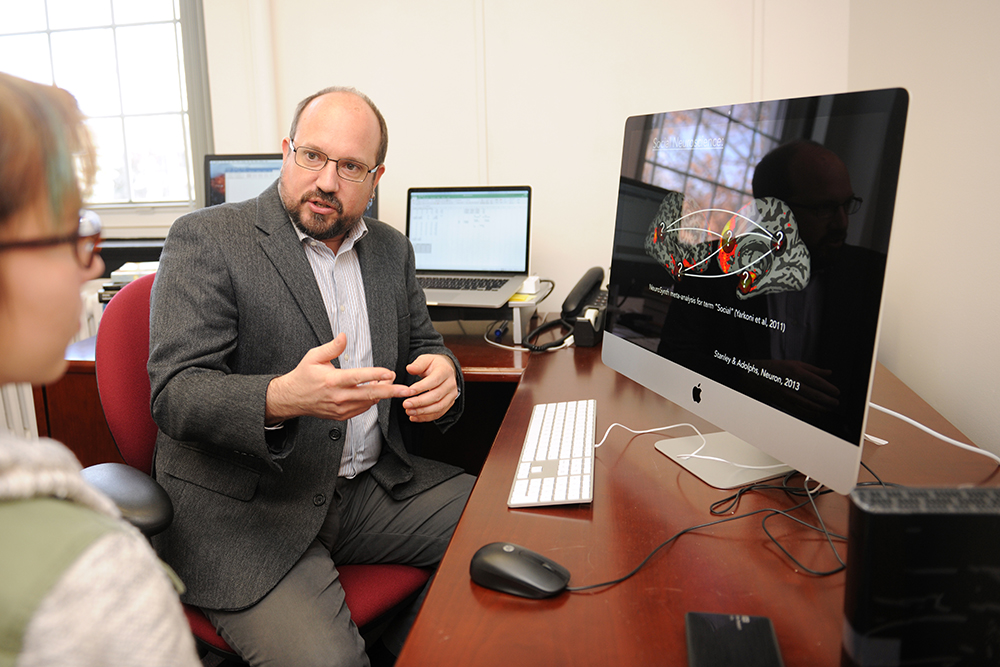Damian Stanley, Ph.D., assistant professor of psychology, has developed a test that may lead to the identification of subcategories of autism and the development of new interventions and/or treatments.

Damian Stanley, Ph.D., assistant professor in Adelphi’s Gordon F. Derner School of Psychology
To maintain friendships, settle disagreements or even get a joke, we need to be able to infer the intentions, emotions and beliefs of others.
Psychologists call this cognitive ability theory of mind (ToM). Difficulties with ToM are one of the hallmarks of autism.
Damian Stanley, Ph.D., an assistant professor in Adelphi’s Gordon F. Derner School of Psychology, has devised a groundbreaking test that sheds new light on the complexities of theory of mind—one that could lead to a better understanding of autism.
Dr. Stanley published results of his test in the February 4, 2019, issue of the journal Current Biology, in an article co-authored by professors from the California Institute of Technology and the University of Toronto Scarborough. Dr. Stanley spends summers at Caltech as a visiting professor.
A classic ToM test goes like this: Show a child a closed box of Band-Aids and ask what’s in the box. The child says “Band-Aids.” Open the box, and it has crayons inside. Ask the child what someone else would expect to find inside the closed box. Kids younger than 4 usually say crayons, because they assume another person knows what they know. Older kids typically reason that another person would see the box’s label and assume there are Band-Aids inside, just like they did.
So theory of mind isn’t just thinking about thinking: It’s understanding who knows what, and when, and predicting what they’ll do with information.
Dr. Stanley came up with a ToM test that he says mimics real life.
“We were aiming to characterize impairments specific to social learning, which is the learning about other people that we must do to understand how to interact with them,” Dr. Stanley says. So the new test is a lot more complex than the Band-Aid boxes test, which almost all high-functioning adults on the autism spectrum can pass easily.
He and his fellow researchers recruited 79 people—26 high-functioning adults on the spectrum and 53 control subjects who are not. For each test, the participant watched another person—we’ll call her Kayla—play an onscreen game in which she has some money and must decide whether to donate it to one of three charities or keep it for herself.
The game also has two modes: one where the game mostly carries out Kayla’s instructions to donate the money or keep it, and a reversal mode where the game mostly does the opposite. Kayla is never sure which mode she’s in, so she has to keep track of what happens to her money and keep the outcomes in mind when deciding about donating.
The test participant must learn from what Kayla does and then gauge her beliefs to predict her future actions. Does Kayla believe she is in a normal or reversal world? Which charities does she like? Which does she not like? What will she do next?
“They have to know what [Kayla] believes and make a judgment call,” Dr. Stanley says.
The test is tough, but Dr. Stanley says people on the spectrum can understand it once it’s explained and practiced. However, people with autism failed at one specific piece: They couldn’t learn to predict when Kayla would donate to a charity and when she would keep the money.
“They had trouble interpreting her actions even though they could learn what she believed,” Dr. Stanley says. “It’s not basic learning or the logical reasoning component that’s impaired in people with autism. What seems to break down is the ability to take into account someone’s beliefs when you’re interpreting their actions. We don’t know if they can’t correctly interpret other’s actions, or if they do but just can’t incorporate the new information [into] their heads.”
The test represents a breakthrough, as it does more than just show whether or not someone has difficulties with theory of mind. It isolates the place in the thought process where a high-functioning adult on the spectrum stumbles. In doing so, it opens the door to identifying and understanding subcategories of autism, a critical next step in the development of interventions and/or treatments.
“We’re able to describe autism in a more nuanced way now, ” Dr. Stanley says. “If we know specifically how something is broken, we can develop better inventions. It’s like a car. If you don’t have a nuanced understanding of what’s under the hood, you won’t know whether you need to add brake fluid or fix the brakes.”
NOTE: Adelphi’s leadership in the field of autism is nationally recognized. Our Bridges to Adelphi program now hosts more than 100 students who are on the spectrum.
For further information, please contact:
Todd Wilson
Strategic Communications Director
p – 516.237.8634
e – twilson@adelphi.edu